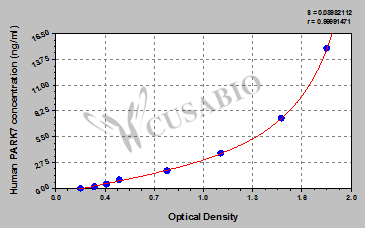Parkinson disease (autosomal recessive, early onset) 7 (PARK7), also known as protein DJ-1, is a multifunctional protein that plays key roles in cellular protection against oxidative stress and mitochondrial dysfunction. This protein functions as an antioxidant and molecular chaperone, helping to maintain cellular homeostasis under stress conditions. PARK7 mutations are associated with early-onset Parkinson's disease. This makes it a valuable biomarker for neurodegenerative research and understanding disease mechanisms related to dopaminergic neuron survival.
The Human Protein DJ-1 (PARK7) ELISA kit (CSB-E12024h) provides quantitative measurement of PARK7 in human samples. This sandwich-based assay works with serum, tissue homogenates, and cell lysates. The detection range spans 0.235 ng/mL to 15 ng/mL with sensitivity of 0.058 ng/mL. The assay requires 50-100 μL sample volume and can be completed within 1-5 hours, with detection performed at 450 nm wavelength.
Application Examples
Note: The following application examples are drawn from a selection of publications citing this product. For additional applications, please refer to the full list of references in the "Citations" section.
This ELISA kit has been used in research studies to measure DJ-1 protein levels in biological samples, particularly focusing on its role as a biomarker in various disease contexts. The kit allows researchers to quantify DJ-1 concentrations in serum and culture medium samples across different experimental conditions.
• Biomarker research: Measuring DJ-1 levels in serum samples for disease-related studies and comparative analyses between different patient populations
• Cell culture studies: Measuring DJ-1 protein secretion or release into culture medium from various cell types under experimental conditions
• Inflammatory research: Studying DJ-1 alongside inflammatory cytokines to explore potential relationships between neurodegeneration-associated proteins and inflammatory responses




